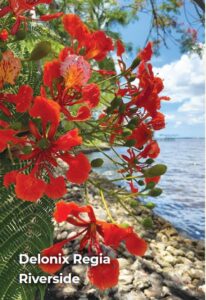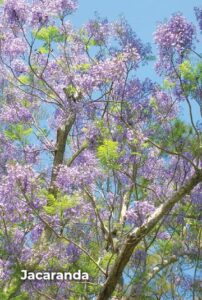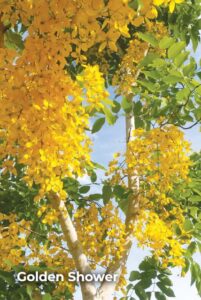The Flamboyant Tree
By Karen Maxwell, Horticultural Specialist
In June, nature opens her jewel box in Southwest Florida. Among the extraordinary collection of flowering shrubs, orchids and perennials, the flowering trees are the showstoppers. Space does not permit me to discuss all of them in this article, but certainly watch for the Jacaranda (Jacaranda mimosifolia), Golden Shower (Cassia fistula), and Yellow Poinciana (Peltophorum pterocarpum) during your early summer stroll around the Estates.
No, I didn’t miss one – Delonix regia, the Royal Poinciana or Flame Tree is perhaps the most celebrated of this elite collection and it has a special place in Florida’s art history. The oldest festival in Miami is the Poinciana Fiesta in proximity to where the oldest Royal Poinciana, located at the Kampong in Coral Gables, was planted by Mrs. David Fairchild in 1917. Closer to home, the Royal Poinciana was documented on our property as far back as the 1880s, but how it came to be on our site, I cannot determine. Over the years, I have enjoyed photographing the many we have had at the Estates – in the parking lot, along the river, on the Ford property, and in Edison’s research gardens. Several were destroyed or badly damaged last September.
Prior to Hurricane Ian, a pair of Royal Poincianas planted by the City of Fort Myers in 1947 created a flaming arch for visitors as they departed the property at the Marlyn Road exit. Native to Madagascar, those of us who are fortunate to reside here in USDA growing zone 10a-10b enjoy the northern range of these tropical trees. They are easily grown from seed extracted from the long, hard brown seed pods, but young plants cannot tolerate temperatures below 50 degrees. Once mature, these drought-tolerant beauties can withstand short temperature dips; however, most of our Royal Poincianas are deciduous due to cooler temperatures during the winter months. In warmer tropical areas, where temperatures rarely drop below 60 degrees, they are evergreen.
Like giant, red umbrellas, one cannot miss a Royal Poinciana in bloom. Generally red, their color ranges from a true yellow through orange to fire red (Arbol de fuego in Spanish speaking countries). The brilliance of the flowers is complemented by a backdrop of complex bi-pinnate leaflets of bright green which fold up at dusk. The Yellow “Poinciana” is not a Delonix regia, but rather a Peltophorum pterocarpum, so we call it a Copperpod to avoid confusion.
The Royal Poincianas of all colors, are distinguished by their unique five-petal flowers, with one petal always significantly larger than the remaining four; it is theorized that this is nature’s design to attract butterfly pollinators. The claw-like shape of the petal gives rise to its botanical name Delonix regia after the Greek “delos” meaning visible and “onyx” meaning claw and the Latin “regia” meaning royal or magnificent. This larger petal is called a standard or a banner. Like all plants in the Legume Family, the Royal Poinciana is useful in soil restoration due to its capacity to convert air-born nitrogen (such as from lightening) to a soil-sourced nitrogen for growth.
The easily distinguished shape of the Royal Poinciana makes it an excellent candidate for Bonsai enthusiasts – the short but large main trunk quickly articulates into heaving branching, creating a tree wider than it is tall. This structure accounts for its vulnerability during heavy wind events and the reaching, extensive, sometimes buttress- like roots can wreak havoc with sidewalks and driveways.
When I picture a Royal Poinciana, I cannot help but imagine some of the landscape artworks created by the Florida Highwaymen – a group of itinerant African American artists based out of the Indian River area and so named in the 1990s by a Florida museum curator, Jim Fitch. Their artwork was primarily of native Florida landscapes that featured cabbage palms and cypress domes, often with sunsets along the river to provide a dramatic focal point in an otherwise heavy canopy of plantings. Reading the history of the Highwaymen is encouraged as I will just be scratching the surface of their legacy here to relate their story to the Royal Poinciana.
During the 1950s through to the 1980s, it is believed that about 200,000 pieces were sold; the original and so-called most valuable pieces were created on Upson (a roofing product) or Masonite and only those are considered by experts as works of the original highwaymen genre. Among the most easily recognized Florida Highwaymen pieces of art, are those that include a Royal Poinciana and the most desired images were created by one of the original six artists – and she was the only woman in the group of 26 inducted into the Florida Hall of Fame in 2004. Because they were not allowed into white art galleries, this mother of seven, an accomplished painter and musician, joined with the other five and took to the road to sell their art door-to-door, thereby providing an income above that of sharecroppers. Mary Ann Carroll* passed away on December 4, 2019 and her work is now among the most highly sought after of the Florida Highwaymen.
“And only the highway woman
Keeps up with the likes of those
And she in all her magic
With hands as quick as light” – Stevie Nicks
If you wish to learn more, I recommend a series of books written by Gary Munroe, including “Mary Ann Carroll, First
Lady of the Highwaymen.” In 2011, Ms. Carroll presented the First Lady, Michelle Obama, with a painting of her favorite subject, the Royal Poinciana.
*Not to be confused with Maryanna Carroll who was a longtime horticulturist/caretaker at Edison and Ford Winter Estates.
Garden BOLO (be on the lookout): During the summer months, the best time to visit is when we open at 9 a.m. Bring your camera and take lots of photos – and I hope you’ll share them with me at kmaxwell@edisonford.org.
Photos: Courtesy of K.M. Maxwell


The Edisons: A Fort Myers Connection
By Timothy Snyder, Lead Historian
Thomas and Mina Edison gave the City of Fort Myers an identity that shaped the socio-economic culture of future generations. The Edisons’ presence in Fort Myers inspired the city to improve and grow in a way that would accommodate a new class of citizenry and provide for an expansion of population that continues today. Thomas and Mina’s winter residency paralleled the growth of Fort Myers as it transformed from a back country stopover for cattle drives, into a major global tourist and winter home destination. By 1910, Edison’s impact on Fort Myers’ civic pride grew, culminating in the 1931 celebration of the great inventor’s final birthday, a long-standing tradition that is still observed. Today, the Edison and Ford Winter Estates is the link to 19th century Fort Myers, reminding locals of their heritage, as well as the progress of the City of Palms.
Much to the amazement of residents, Thomas Edison arrived at Punta Rassa, a peninsula located at the mouth of the Caloosahatchee River on March 15, 1885. While staying there, he traveled upriver to the small town of Fort Myers to inquire about purchasing land. After depositing $100 on 13 acres along the Caloosahatchee, he signed a contract to provide the remainder and purchased the property for $2,750.
As the Edison estate was being established, the town of Fort Myers was also being established. Perhaps the appearance of Edison helped inspire the residents to act. On August 12, 1885, a town meeting was held, and the residents voted unanimously 45 to 0 to proceed with incorporation. After their wedding on February 24, 1886, the Edisons headed for their new winter estate in Fort Myers, arriving on March 15 and staying until April 26. During their stay the following year, electricity was added. As residents witnessed the electrification of the buildings, the people of this small Southwest Florida town were introduced to the modern world.
The Edisons established a tradition of arriving each winter at the turn of the 20th century, which provoked a sense of pride and ownership in Fort Myers’ residents. The local press often leaked the story of Edison’s arrival in advance, and a crowd usually gathered at the train depot to greet them. During Edison’s 1907 visit, the City voted to install sidewalks, Edison bought a membership to the Fort Myers Yacht and Country Club, they visited the Fort Myers Women’s Club and Mina donated $120 toward the construction of a new library. Thomas Edison offered to plant one mile of royal palm trees along riverside drive; the offer included “the furnishing and planting of hundreds of trees, constructing a protective box around each tree, fertilization and care for one year, and necessary replacements for two years conditioned only on the town’s willingness to care for the trees thereafter” (Smoot pg. 81).
During the first decade of the 1900s, Thomas and Mina’s involvement and influence on local matters began to take off. The town of Fort Myers embraced the most famous inventor of the century, and he became big news on each arrival. An example of the pride and admiration that locals had for the wizard is exemplified by events that took place in town: on March 18, 1909, a grand reception for the inventor was held at the Royal Palm Hotel and then on March 9, 1910, Edison was the guest of honor at the town’s 25th anniversary celebration, which included a parade with floats, automobiles and a cowboy procession.
Not to be outdone, Mina in the same winter held a reception at Seminole Lodge, including a concert in which band members played from the pergola between the two houses. The town also grew in grandeur as exemplified by the 1910 grand opening of the Royal Palm Theater, boasting silent movies followed by live entertainment. The 1915 construction of the Arcade Theater demonstrated the desire for culture and entertainment, quickly becoming a major attraction for locals and visitors alike.
Another step toward modernization was the construction of two schools during 1913 and 1914 and the city’s first hospital was completed in 1916, saving people from being transported to Tampa or Key West for critical care. The hospital was named Lee Memorial and was a two-story structure with four patient rooms, as well as an operating room.
The Edisons explored the South Florida countryside via the Caloosahatchee as well as the local trails, often employing the Menge brothers’ steamboat captains to guide them up and down the river. They ventured all the way to Lake Okeechobee in 1906, and 1912, and went camping in the everglades with the Fords and John Burroughs in 1914. Edison’s attachment to Fort Myers blossomed into civic pride leading into his final decade.
During the roaring 20s, Fort Myers grew exponentially both in population and in property. A toll bridge to Fort Myers Beach was constructed in 1921, connecting the mainland to Estero Island. Motorists were charged 54 cents per crossing. Then, in 1924, a wooden bridge was built across the Caloosahatchee as part of the new Tamiami Trail highway. The bridge not only connected the town to northern destinations but also sparked a local real estate boom.
In 1925, the city expanded its limits to include 15,000 acres – perhaps inspired by a Thomas Edison quote: “there is only one Fort Myers, and 90 million people will find this out.” The years of 1925 and 1926 brought in more than $5 million in building permit revenues as developers began to create communities within the city limits and provided paved roads to support them. During this decade, multi- storied buildings such as the seven-floor annex to the Franklin Arms Hotel and the four-story Knights of Pythias building blossomed in Fort Myers. In February 1928, local residents demonstrated their appreciation for the famed scientist with a grand birthday celebration, held at the pleasure pier downtown. Around 4,000 school students, a live band, and hundreds of other locals attended. Thomas’ 1929 birthday celebration included a parade tour of the town with President elect Herbert Hoover.
Mina Edison’s impact on local society also increased during the decade. Forming the Roundtable organization, Mina helped to coordinate civic groups to work together on the beautification of their town. As President of the Plant Guild, she personally headed the Safety Hill Garden Club division, in which she inspired the community to pave the roads and beautify the landscape throughout their neighborhoods. Mina’s impact on the community was demonstrated by her involvement in the Young Men’s Wesley Bible Class, speaking engagements for the Chamber of Commerce, Girl Scout Troup 2, the Junior High School PTA and the Rotary Club.
The roaring twenties sputtered to an end, but not before the completion of the Tamiami Trail, which connected Tampa to Miami for motorists. This also began a new tradition for the Edisons who would travel to Miami, Everglades City, and Naples in their motor car, chauffeured by Sidney Scarth.
Thomas Edison celebrated his final birthday in Fort Myers during his 1931 visit in grand fashion. The city dedicated its new concrete automobile bridge across the Caloosahatchee to him. What better way than to celebrate the inventor’s birthday than to have him head the opening ceremony of the new bridge. Edison was escorted from Seminole Lodge to the fountain at the intersection of McGregor by 20 high school students where the parade began. The procession ended with a ribbon cutting ceremony at the foot of the bridge. In attendance was Governor Carlton, Mayor Fitch, Harvey Firestone, and the head of the road department.
Mina Edison deeded the Edison estate to the City of Fort Myers on February 18, 1947. Today, the estate remains a link to the past, reminding residents of their heritage and connection to the Edison legacy. That legacy lives on in Fort Myers with the preservation of the Edison and Ford Winter Estates.